In the Page Designer, you can add, modify, hide or delete fields on a record page. You can also manage the structure of the section data (i.e., the list of section columns): adding a new column in the Page Designer, will also add this column to the data structure of the section when you save the changes.
Adding page fields based on existing section columns
The [Existing columns] block of the [Page elements] menu displays columns that are already available in the section. These columns may not be displayed on the record page, but they are used in the Creatio database and cannot be deleted.
Some of the columns may be required on the object level: you cannot create a record in the database if you do not populate the required record columns. The required columns are marked with an “asterisk” (*) character (Fig. 1).
Attention
All required columns must be added as fields to the record page to ensure that the record page opens correctly.
Fig. 1 A required field in the Page Designer
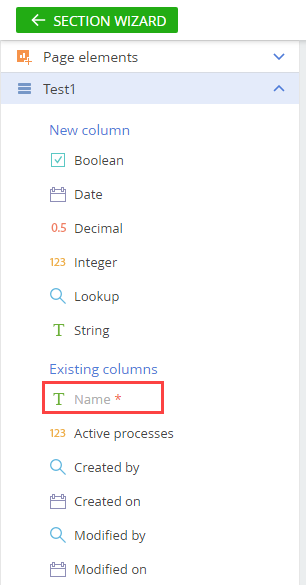
To add existing columns to the page:
1.Open a section, e.g., [Requests].
2.Click [View] -> [Open Section Wizard].
3.In the “Section pages” block of the Section Wizard:
• if you have only one edit page in your section, click [Edit page];
• if you have several edit pages in your section, click the link of a corresponding page in the list.
4.Drag existing columns from the [Existing columns] area to the record page.
The areas where you can drop the field are highlighted. The columns that are already added to the page do not disappear from the column selection field, but they become unavailable in the list of existing columns (Fig. 2).
Fig. 2 Adding existing columns to a record page

Attention
When you add a new column to a page in the Page Designer and accidentally drop it on top of other columns, the new column will not appear in the Page Designer working area. It will be added to the list of the existing columns instead (Fig. 3). To display it on the page, drag it from the existing columns to the working area of the Page Designer and do not create a new column with the same name.
Fig. 3 Dropping columns on top of the displayed columns in the Page Designer
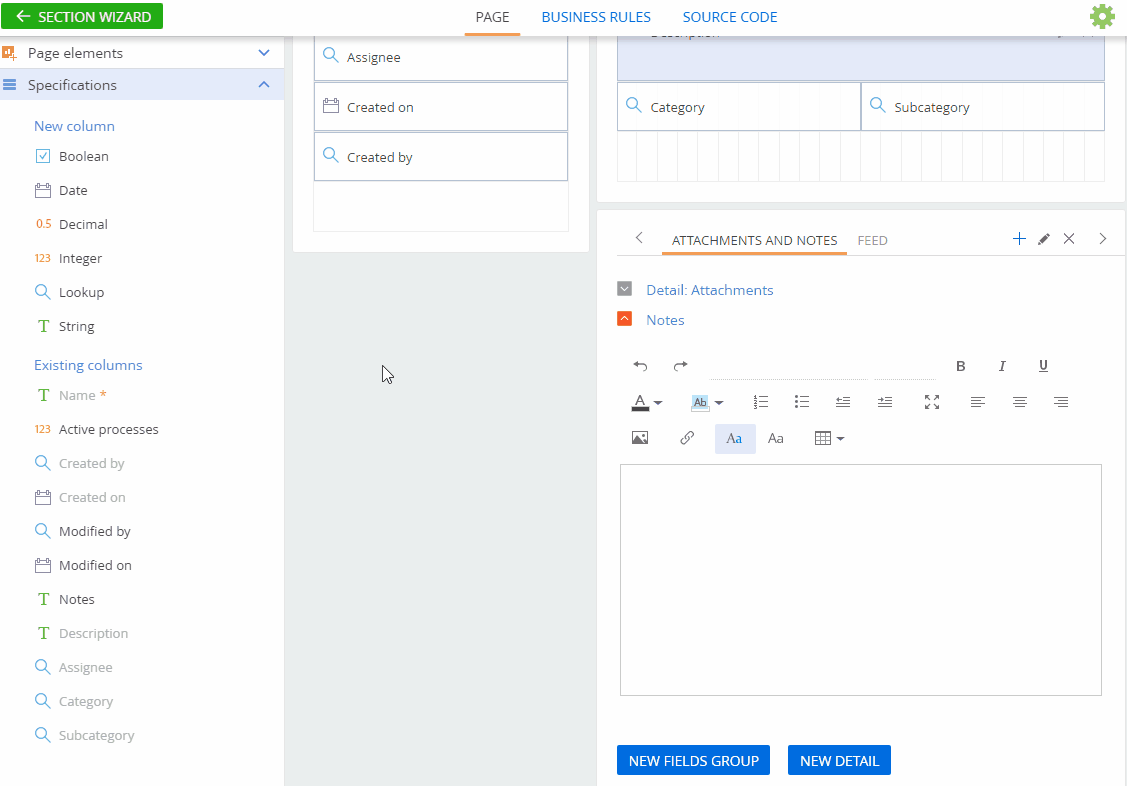
To change the column width, drag the edge of a corresponding field to make it large enough.
In multiline text fields, you can also change the column height (Fig. 4).
Fig. 4 Changing the size of a multiline column

To modify the column properties, highlight it and click  (Fig. 5).
(Fig. 5).
Fig. 5 Editing columns in the Page Designer

To delete a field from the page, highlight it and click  (Fig. 6).
(Fig. 6).
Fig. 6 Deleting columns from a record page
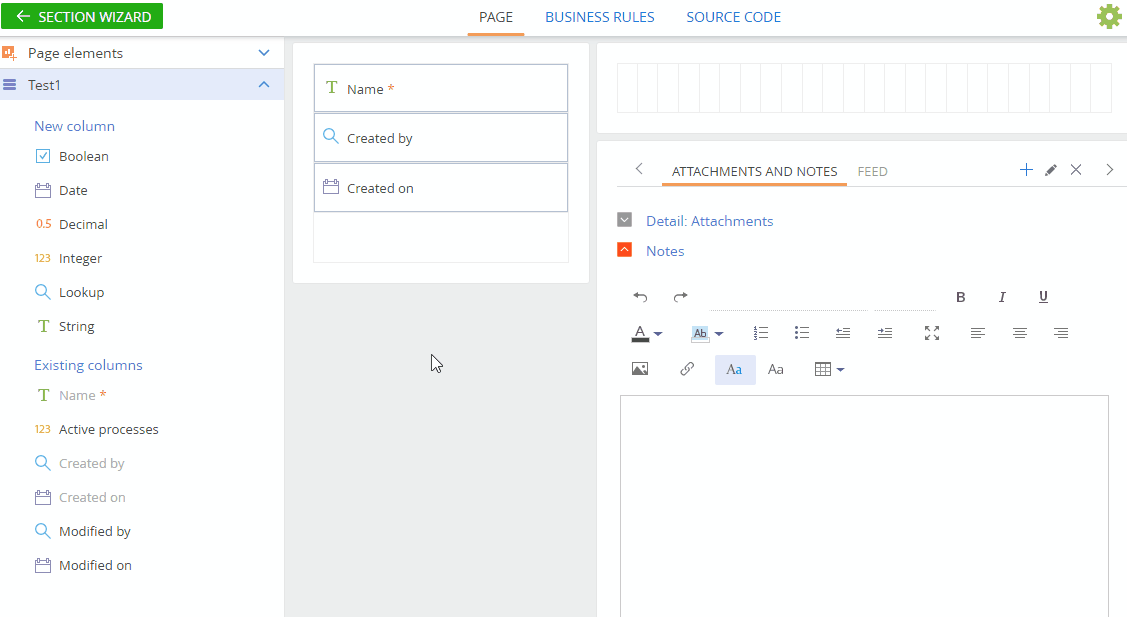
Attention
Removing a field from the page will not delete the corresponding column from the section object. You can delete an object column through the [Configuration] section only. You can delete only the columns that were created by you and only if they have not been added to any other pages. Base columns, such as “Id,” “Created by,” etc., cannot be deleted.
Adding new columns to a section
The [New column] block of the Page elements area displays available types of columns that you can add to the section. Below is the list of the types of columns that you can add.
| Column type | Type of field on the page | Example |
|---|---|---|
|
| A text field. String fields can contain letters, numbers and other characters. Multiline text fields enable line breaks and can have a variable height. String fields have several additional parameters. | Single line fields: the [Full name] and [Full job title] fields on the contact page. |
|
| A numeric field that can only contain whole numbers (no fractional numbers). If you use a field of the “Integer” type on the page, the analytical data that are generated based on the values of this field will be displayed rounded up to integers. | The [Duration (minutes)] column in the [Activities] section (does not display on the activity page by default). |
|
| A numeric field that can contain fractional numbers. | The [Payment amount] field on the invoice page. |
|
| Date fields are necessary for registering calendar information. | The [Start] and [Due] fields on the activity page. |
|
| Enables you to select values from a list that was created manually or imported. The values available in the list are stored in the corresponding lookups. Users can populate lookup fields either by selecting a value from a drop-down list or the pop-up lookup window. Lookup fields have several additional parameters. | Drop-down list lookup fields: the [Type] and [Role] fields on the contact page. Pop-up window lookup fields: the [Owner] and [Reporter] fields on the activity page. |
|
| Can contain one of the two logic values: “Yes/No.” A Boolean field cannot be required. | “Checkbox” fields, such as the [Remind owner], [Remind author] fields on the activity page, etc. |
To add new columns to the section:
1.Open a section, e.g., [Requests].
2.Click [View] -> [Open Section Wizard].
3.In the “Section pages” block of the Section Wizard:
• if you have only one edit page in your section, click [Edit page];
• if you have several edit pages in your section, click the link of a corresponding page in the list.
4.Select the needed type of column in the [New column] area and drag it to the page similarly to working with the existing columns (Fig. 7).
Dragging and dropping a new column to the section page will add a new field of the corresponding type and a new corresponding column to the database.
Fig. 7 Adding new columns to a record page
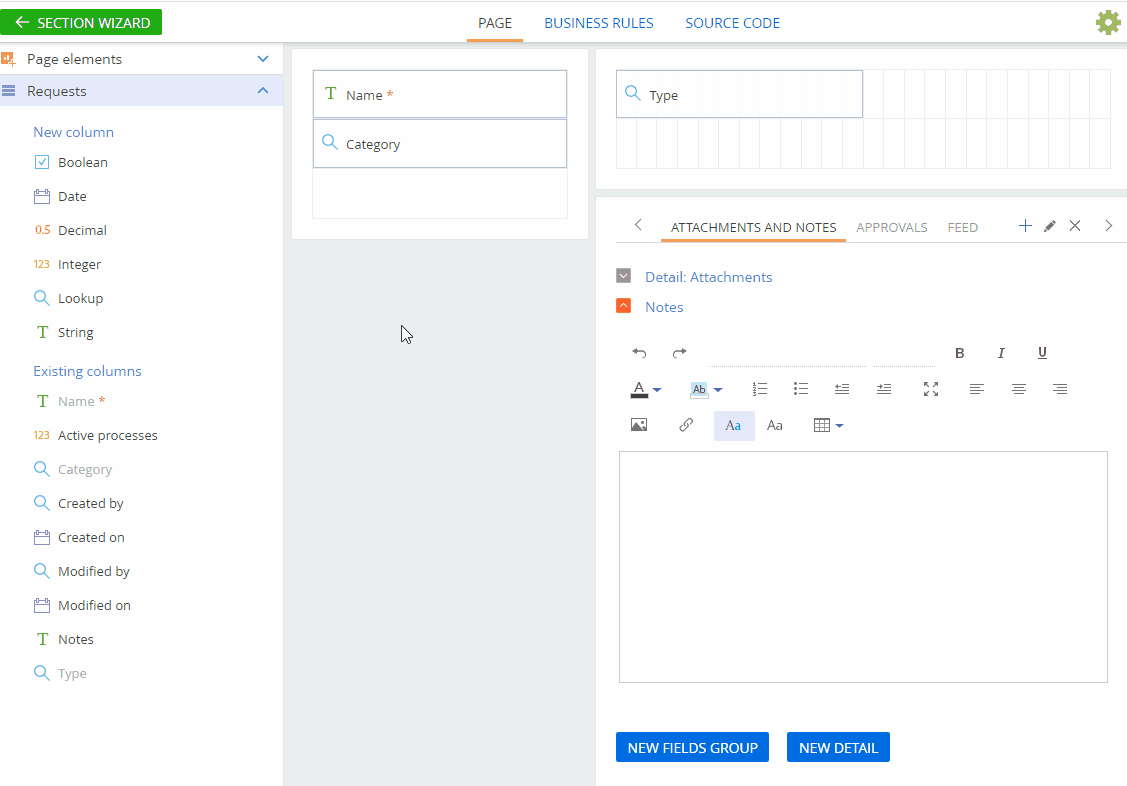
Attention!
When you add a new field to a page, the corresponding column is added to the section object, once you save the changes in the Section Wizard.
Specify the parameters of the new column and the page field used to populate it. The set of available parameters (Fig. 8) may differ depending on the field type.
Fig. 8 Example of the [Subcategory] field parameters on a request page
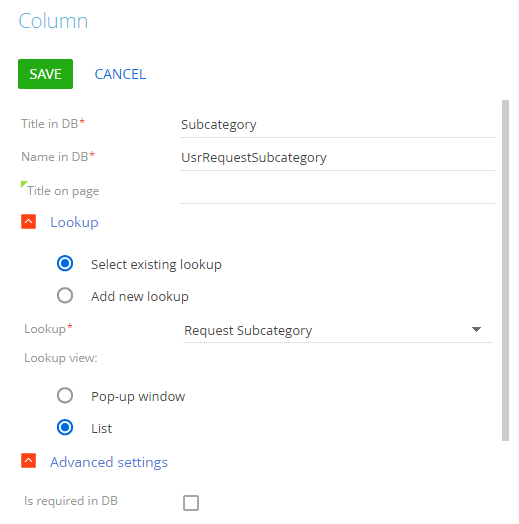
Common parameters for all columns
| Parameter | Description |
|---|---|
| Title in DB | The field caption that will display in the section list and on the record page (provided that the [Title on page] field is unpopulated. The field title remains in the database and is displayed on all section record pages. |
| Name in DB | The unique name for the column in the Creatio database. The column name cannot contain non-Latin characters and spaces. Creatio will warn you if a column with the same name already exists. Names of custom columns must contain a prefix. The prefix is specified in the “Prefix for object name” (SchemaNamePrefix) system setting. By default, the prefix is “Usr.” |
| Title on page | Used to make a field title on the record page different from the field title in the list. If the [Title on page] field is not populated, Creatio will use [Title in DB] parameter as the field’s page and list captions. |
| Is required in DB | Select this checkbox if the new field must be populated before a user can save a new record. This checkbox is not available for fields of the “Boolean,” “Integer” and “Decimal” types. |
| Read-only | Select this checkbox if the new field must be grayed out when the page opens. |
| Hide caption | Select this checkbox if you need to hide the field title on the record page. |
| Make copy | Select this checkbox if you need to copy the value of this field when you copy the entire record. If a column contains values that must be unique for each record (such as invoice number, for example), do not select this checkbox for this column. |
Parameters for the “String” columns
The [Multiline text] checkbox is unique to “String” fields. Multiline text fields have variable height and are designed for entering larger volumes of text that might take several paragraphs, such as the [Description] field. If you select the [Multiline text] checkbox, you will be able to modify the field height in the Page Designer by simply dragging it to the size you need (Fig. 9).
Leave the [Multiline text] checkbox cleared to add a single-line text field.
Note
By default, all string fields can contain 250 characters. You can change the length of a string field in the object designer, using the [Advanced settings] section.
Fig. 9 Changing the size of a multiline column
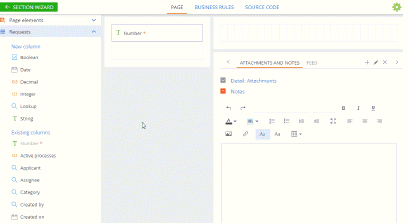
Parameters for the “Lookup” columns
A lookup column is populated by selecting a value from a list. For a lookup column, you need to specify the object to use as the lookup, the lookup view and the type of connection between the records in the current object tan the lookup object.
Lookup object
The list of lookup values is based on the records of an object (the “lookup object”). You can use any object as a lookup object. Depending on whether the needed object already exists, select the [Select existing lookup] or [Add new lookup] option.
If you are adding a lookup field for an existing lookup, select the lookup object in the [Lookup] field. For example, select the “Contact” object as a lookup for the [Owner] field (Fig. 10).
Fig. 10 Selecting an existing lookup

Selecting [Add new lookup] will add a new object to Creatio. You need to specify the name and title for the new lookup object (Fig. 11):
Fig. 11 Adding a new lookup field

a.[Title] – a title that will distinguish your lookup object from other objects.
b.[Name] – a code for the new lookup object in the database. The object name must contain a prefix. You can specify the prefix in the “Prefix for object name” (SchemaNamePrefix) system setting. By default, the “Usr” value is used.
Note
After you save the changes in the Section Wizard, a new lookup will automatically be registered in Creatio and bound to the package where the wizard saves changes. The lookup name will match the one that you indicate in the [Title] field. You can view and modify the lookup content via the [Lookups section].
Lookup view
The lookup view determines the type of field that will represent a lookup column on a page:
-
Select the [List] display method to make the lookup field a drop-down list (Fig. 12).
Fig. 12 Example of a drop-down list view of a lookup field

-
Select the [Pop-up window] display method to open a separate lookup window (Fig. 13) for selecting the value. In the pop-up window, you will be able to filter, edit or delete existing lookup records, as well as add new ones. This display method is a good option if you use an object of another section, e.g., the [Contacts] section, as a lookup.
Fig. 13 Lookup value selection window
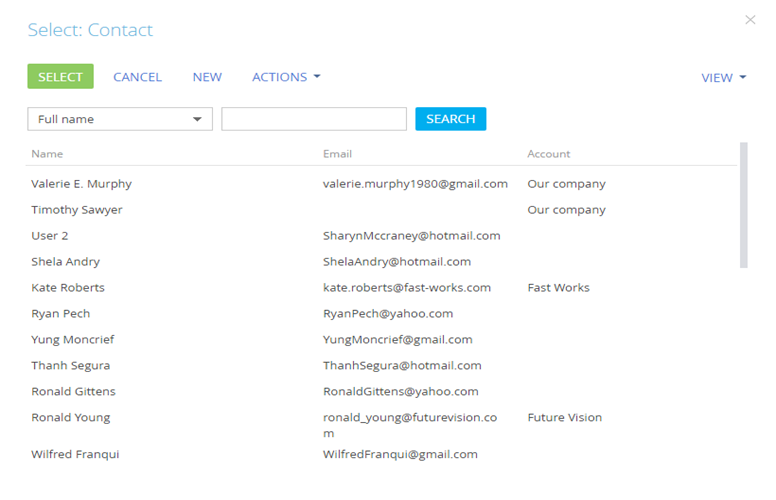
Cascade connection
Select the [Cascade connection] checkbox in the [Advanced settings] area if you need to establish a connection between the records of the current section object and the object specified in the [Lookup] field. As a result, whenever a record is deleted from the lookup object, any linked records of the current object will be deleted as well.
The [Cascade connection] checkbox is usually selected for the lookup fields in detail objects – the fields that link the detail object to the section object. For example, the “Contact address” object has the [Contact] lookup column designed to link each address record to a specific contact. Whenever you delete a contact from the [Contacts] section, all addresses of that contact must be deleted as well. Therefore, the [Cascade connection] checkbox must be selected for the [Contact] column in the “Contact address” object.
See also







 String
String Integer
Integer Decimal
Decimal Date
Date Lookup
Lookup Boolean
Boolean